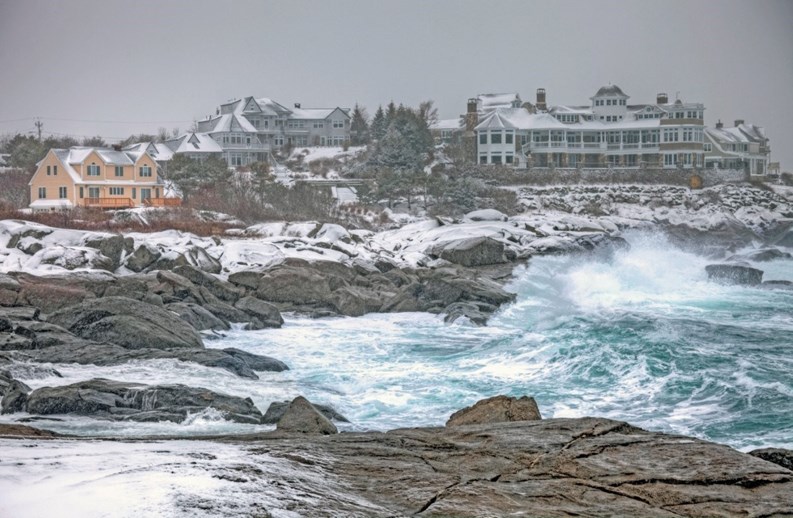For many, having a home by the ocean is the embodiment of a dream come true. For condominium managers and board members, though, there is also the responsibility of caring for and protecting these homes from the added wear-and-tear caused by the ocean itself. With the proper planning and maintenance, however, those problems can be minimized and potentially eliminated, restoring peace of mind to seaside living.
So what does an oceanside condo face that other inland homes do not? While most inland homes are protected by trees, hills and other structures, most seaside residences face the ocean unprotected with nothing to disrupt high winds, fierce storms or unrelenting sunlight. “These homes have to endure more,” says Matthew Coulsey, a projectmanager with Noblin & Associates Engineers, based in Bridgewater, Massachusetts. “They get more sunlight, more wind and more wind-driven, horizontal rain. A building out in Framingham [Massachusetts] won’t have those types of issues.”
Comparing wear and tear between oceanfront properties and their inland counterparts, “you can go a mile inland from Boston Harbor and the materials you use might hold up for a year. Get closer to the ocean, and they might last three to six months,” says Peter Seoane, vice president and general manager of Stuart Dean, an architectural restorationand maintenance firm located in Boston, Massachusetts.
Severe Winds
Among the many problems that can face seaside homes, wind can be one of the most severe, driving moisture into buildings, tearing off shingles and, in very heavy storms, doing significant damage to roofs. “When wind passes around buildings, it creates a vortex,” says Bob Burns, principal of Burns Associates - Engineers of Portsmouth, New Hampshire. “It creates a negative pressure within the living spaces, whichcauses a vacuum.” Water or mist outside the building then gets pulled in through that vacuum, potentially causing damage to the home later on.
Taller buildings can also face more potential damage from wind. “The taller the building, the more surface is exposed to the wind,” Burns says. “The further you get from the ground, the worse it is.” The ground itself offers friction that can help reduce wind speed.
That same wind also can cause damage to shingles. With steep roofs, the kind that are quite popular in many oceanside constructions, more surface area is presented to storms and high winds. “With lower steeped roofs, the wind can skim over and pass by,” Burns says. But when the wind catches on steeper roofs, it can get underneath shingles and create lift, pulling the material up and down. “Older, brittle shingles don’t like to flex much,” Burns says. “They just crack. They break up and fly away.”
Salt is another problem that arises with proximity to ocean waters. “Whenever you have airborne salt, it can lead to deposits on surfaces,” says Seoane. Architectural metals, for example, are affected by salt. “It can accelerate the natural decomposition of metals,” he says.
Salt Can Be Trouble
Coulsey agrees. “The corrosive nature of salt can cause trouble,” he says. Proximity to the ocean “is going to help determine what types of products and materials are used.” Meaning aluminum, for example, may not be the best choice because it will degrade so much more quickly. In building and retrofitting structures near the sea, “more expensive, more durable materials” will be used more often.
Beyond metals, salt can affect other materials. “It can be corrosive even for stone,” Seoane says. “When it’s deposited on marble floors, it can eat away the actual stone.”
Extended sun exposure also may pose issues for the long-term aesthetics of buildings, says Coulsey. “On the Cape, you see a lot of wood shingle siding. Sun degrades wood faster. When it beatsdown on wood products, it will curl and rot the wood more quickly than it would in a protected environment.”
More than anything else, though, the harsh nature of the storms that roll ashore throughout the year bear the most risk for seaside properties. Again, while natural and man-made obstructions can help reduce the force of a storm that rages in off the ocean, homes situated along those unprotectedshores do not have that advantage.
“Hail storms can really have a severe effect on asphalt shingles,” says Burns. “It’ll start loosening the grit on those shingles, which can cause them to lose some of their surface life.”
Those storms also bring copious amounts of water, and as with any structure, water can be the single mostdestructive element out there. “Most damage happens because of water that gets into buildings,” says Burns. Water is even more insidious because it can seep into the envelope of a building or house and go unseen until it has done enough damage to get noticed.
Flashing, Flashing and Flashing
Luckily, with the right combination of products, protections and planning, most oceanside homes and buildings can weather the harshest elements. The best way to deal with water, for example, is to make it as difficult as possible for it to infiltrate the home in the first place. “The three most important things to consider are flashing, flashing and flashing,” says Burns. “It prevents moisture penetration into windows and walls. Put flashing over flashing. It’s a belt and suspenders principle. And have an intentional idea of where you want the water to go, should it penetrate that initial barrier.” A second barrier can deflect that first breach and if that gets through, a third barrier will deflect it further.
Installing a draining plane under the siding can help drain water away from the structure. “It’s a capillary effect,” says Burns. The draining plane is “made of a matrix of plastic material like netting, half an inch to three-quarters of an inch thick.” That mat is installedagainst the sheathing of the building, then the siding is put back and when water makes its way inside the wall space, the plastic material directs the water downward using gravity. “It’s pretty much standard now in new construction,” Burns says.
Installing baffled ridge vents also can help keep water at bay. “Vents that are baffled let air escape but also prevent water from entering, and are relatively inexpensive,” Burns says.
To reduce wind damage on shingles, Burns suggests applying a roof guard, which is a special coating that seals the shingles and, among other things, reduces wind effects by binding the surface together and reducing the chances of wind getting under the shingles and pulling them off. It also helps waterproof and insulate the roof area.
Seoane suggests using a high-performance paint coating with resistanceto salt when it comes time to giving condos a touch of color. “If it’s something that is a coating, it should be resistant to temperature, wind and UV,” he says, adding it should also have good adhesion properties.
Tougher Windows
Installing tougher windows also can go a long way toward protecting a seaside home, says Coulsey. Hurricane-resistant windows, glazing and doors, although not required by code, should be looked into for the type of protection they can offer in terms of long-term durability. “If an object comes hurtling toward the building (in a storm), it won’t smash the window,” Coulsey says. “Instead, it will crack like a windshield.” That not only provides safety for the home’s inhabitants, it could also end up protecting the entire structure. “As soon as a building is compromised with wind coming in, that air is trying to destroy the building,” he says. In short, under extreme circumstances, the wind that comes inthrough broken windows in a storm can provide the force necessary to try and push the roof off a building.
Says Seoane, “The same windows that work inland might not stand up, due to the violence of winds and storms.” The investment in sturdier materials might well be worthwhile down the line.
Perhaps one of the best ways to protect an ocean property is to institute a frequent maintenance and evaluation regimen. “You have to use a more aggressive maintenance schedule,” says Coulsey. “You need to paint more frequently, do shingle replacements more frequently.”
To protect and extend the life of siding, management might want to “pressure wash or hose down the surfaces on a monthly basis,” says Seoane.
Engaging in regular inspections also can help stop problems before they get out of control. “It’s certainly beneficialto have experts come out,” Coulsey says. “They can see what the average eye doesn’t pick up,” especially if management doesn’t know how the buildings were constructed or what materials were used originally.
“From an aesthetic standpoint, (anyone) can see deterioration on the surface,” says Seoane. “But there can be water infiltration issues that go unseen. A structural engineer or a person whose expertise is in exterior envelopes could make an assessment.”
While special considerations do indeed have to be made for the care and protection of oceanside properties, most condo owners would agree it’s worth the time and effort. Just one look at a spectacular sunset or a few minutes listening to the soothing sound of the waves can make that case quite well.
Liz Lent is a freelance writer and a frequent contributor to New England Condominium magazine.







Leave a Comment